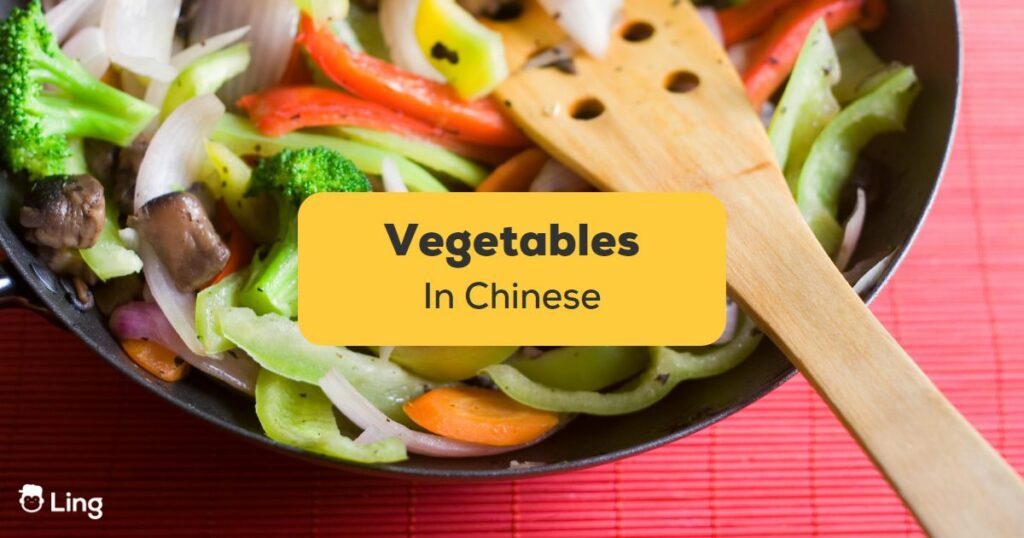If you’re not a fan of vegetable dishes, then you haven’t tried Chinese dishes yet! But before you do, make sure to learn some vegetables in Chinese, so that you can decide what to eat from a menu full of Chinese names.
We all want to eat healthier by cutting down on carbs and sugar from time to time, and I think the best choice would be vegetable stir-fries from Chinese cuisine. If you haven’t eaten stir-fries with Chinese vegetables, you should head to a Chinese restaurant nearby! Also, if you’re a vegan or vegetarian, you can find various tasty dishes according to your special diet.
In this blog post, you’ll learn all about vegetables in Chinese and which of them are native to China. Let’s dive into it!
Page Contents
- How Do You Say Vegetables In Chinese?
- What Vegetables Are Native To China?
- Chinese Vocabulary For Vegetables
- Start Learning Chinese With Ling!
How Do You Say “Vegetable” In Chinese?
Before you learn the Chinese vocabulary for different vegetables used in Chinese cuisine, let’s learn how to say the word vegetable in the Chinese language first. Vegetable is “蔬菜 (shū cài)” in Chinese, and also, if you were wondering, vegetarian is “素食 (sù shí).”

What Vegetables Are Native To China?
China has a rich agricultural history, and many vegetables that are commonly used in Chinese cuisine today have been grown in the country and used in traditional Chinese dishes for thousands of years. Some vegetables that are native to China include:
1. Bok Choy: Bok choy, also known as Chinese cabbage, is a leafy green vegetable that is commonly used in Chinese cuisine. It has been cultivated in China for over 1,500 years.
2. Chinese Broccoli: Also known as gai lan, Chinese broccoli has long, dark green leaves and thick stems. It is often used in stir-fry dishes and has been cultivated in China for over 2,000 years.
3. Chinese Eggplant: Chinese eggplant is a long, slender variety of eggplant that is commonly used in stir-fry dishes and stews. It has also been cultivated in China for over 1,500 years.
4. Chinese Cabbage: Chinese cabbage, also known as napa cabbage, is a leafy green vegetable similar to Western cabbage but with a milder flavor. Like Bok choy and Chinese Eggplant, Chinese people have cultivated it for over 1,500 years.
5. Bean Sprouts: Bean sprouts are a common ingredient in Chinese cuisine and are used in stir-fried dishes, salads, and soups. They are made by sprouting mung beans and have been popular in China for around 2,000 years.
6. Chinese Spinach: Chinese spinach, also known as amaranth, is a leafy green vegetable that is rich in vitamins and minerals. It has also been cultivated in China for over 2,000 years, and is commonly used in stir-fried dishes and soups.
Other vegetables native to China include snow peas, water chestnuts, lotus root, and Chinese yam.
Vocabulary For Chinese Vegetables
Chinese cuisine contains a lot of veggies as main ingredients.
Here are some vocabulary words for common Chinese vegetables:
These are just a few examples of the extensive vegetable vocabulary in Chinese. After learning these words, you can talk about food and other cooking topics in Chinese more comprehensively.
If you’re just getting started learning Chinese and looking for useful resources to self-study at home, you’ve come to the right place! Check out some information about the Ling app right below!
Start Learning Chinese With Ling!
If you want to learn Chinese, or the other 60+ languages offered in the app, Ling is here for you!

There are more than 60 foreign language courses on the Ling App, including Chinese! You just have to download the app on your mobile device to start learning any of them right away!
With Ling, you can learn to write Chinese characters, listen to native Chinese speakers and repeat their pronunciation, and do various mini-activities to learn Chinese vocabulary and phrases. Plus, you can always review what you have already learned. Last but not least, you can practice your pronunciation and speaking skills by conversing with AI chatbots.
Furthermore, don’t miss out on weekly blog posts on Ling’s Chinese blog to learn more about Chinese culture and language! You may be interested in these articles about Chinese grammar and idioms.
So download the Ling app from Google Play Store or Apple App Store, and start learning Chinese right now!
Until next time!



































































